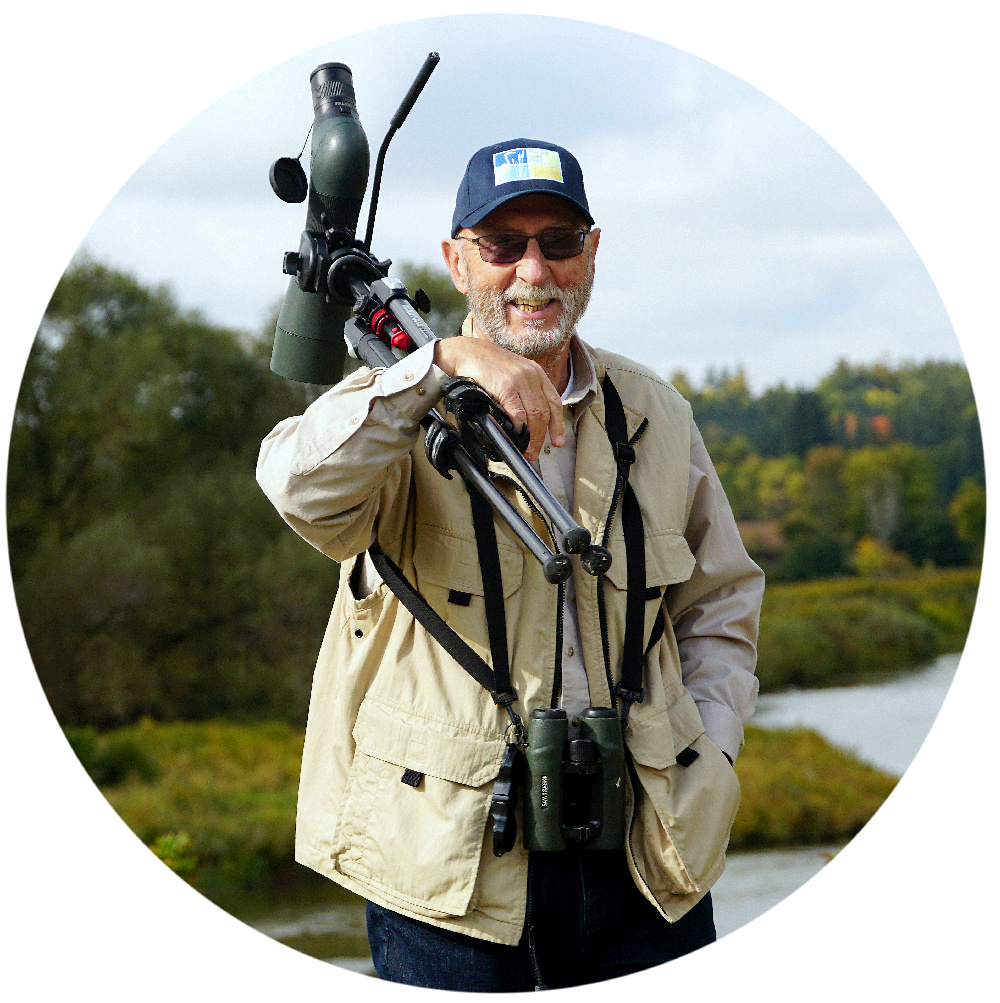A sure sign that the year is rapidly moving ahead is the return of shorebirds from their northern breeding grounds. Although Waterloo Region is not a major stopping off point for these southbound migrants there are many places where small numbers can be observed.
We have recently been spending an hour or so each afternoon checking out a small area in the village of Erbsville right at the edge of the City of Waterloo which is soon to be enveloped by a major new subdivision which has been approved. Without a doubt some of the natural areas will be imperiled and we are not sure whether this small area will be drained or otherwise destroyed.
It was very pleasant to find a Solitary Sandpiper Tringa solitaria feeding in the mud which is rich in invertebrate prey.
This species breeds right across the Nearctic region of North America and adults are already winging their way to their winter quarters in South America.
The feeding seemed to be particularly rich with many fat worms being captured.
The Kildeer Chardrius vociferus breeds locally and it was quite numerous, also taking advantage of the nutritious and easily captured food in the mud.
In my last post I included a picture of a male Ebony Jewelwing Calopteryx maculata and I now include a female.
The white wingtips which identify the female are actually pseudostigma, or false (ptero) stigma. Unlike a true stigma a pseudostigma is made up of multiple cells. In our area only female jewelwings display this character.
Northern Leopard Frogs Lithobates pipiens seem to have had a productive breeding season and as we walked along young frogs were constantly hopping out of our way, seeking refuge in the water.
Blue Vervain Verbena hastata was in bloom everywhere; it is a very characteristic plant of damp thickets and roadsides and was abundant where we walked along a dirt road adjacent to wet areas.
This area is not large but is home to a variety of organisms and we can only hope that the urban planners have recognized its value and will protect it.
Sunday, July 31, 2016
Solitary Sandpiper (Chevalier solitaire) and Killdeer (Pluvier kildir)
David M. Gascoigne, Sunday, July 31, 2016
Marcadores:
Blue Vervain,
Ebony Jewelwing,
Erbsville,
Killdeer,
Northern Leopard Frog,
Solitary Sandpiper

David M. Gascoigne,
I'm a life long birder. My interests are birds, nature, reading, books, outdoors, travel, food and wine.
you may also like
Subscribe to:
Post Comments (Atom)
Land Acknowledgement
We acknowledge that the land on which we are situated are the lands traditionally used by the Haudenosaunee, Anishinaabe, and Neutral People. We also acknowledge the enduring presence and deep traditional knowledge, laws, and philosophies of the Indigenous Peoples with whom we share this land today. We are all treaty people with a responsibility to honour all our relations.
Followers
Welcome

My name is David. I'm a lifelong birder, fiercely committed to all of nature, however. Married to Miriam Bauman. I love to travel. I Enjoy a good book and a good glass of wine. To read more about me, click my ABOUT page.
Follow by Email
Search This Blog
Blog Archive
Popular Posts
-
23 October, 2025 Predictably, Mallards ( Anas platyrynchos ) were easily found. You will note just left of centre in the picture...
-
I am quite confident in my judgement when I say that nuthatches (Family Sittidae ), small birds with a remarkable ability to scurry dow...
-
22 November, 2025 Leader: David M. Gascoigne Participants: Farid Asey, Heela Asey, Mina Asey, Palwasha Asey, Sameer Asey, Mary Ann Cassidy, ...
-
It has been a long time since I received those annoying, “Fail to publish, please try again later,” notices, but it is happening aga...
-
02 November, 2025 We had been invited to take a stroll though Laurel Creek C.A. with good friends, Dave and Mary, followed by coffee ...
-
29 November, 2025 After a snowy overnight, with everywhere white and glistening, it was a perfect day for an outing with our little Pri...
-
I just returned from a successful and highly enjoyable visit to Colombia with birding friends. We'll all have very fond memories fo...
-
“To raise a nature-bonded child is to raise a rebel, a dreamer, an innovator… someone who will walk their own verdant, winding path.” Nicol...
-
Mere days ago I was having a discussion with a friend about the exclusion of women from so many aspects of society in certain parts o...
-
As I continue to be afforded the great pleasure of leading outings for Waterloo Region Nature, I am offering two options for local de...



























Buen reportaje David, me ha gustado mucho. Por mi pueblo también se empiezan a ver los limícolas que empiezan a bajar del norte. Un fuerte abrazo desde España.
ReplyDelete2 waders that would be very nice finds for a birder in Europe or Asia!
ReplyDeleteNice series of pics.. Happy weekend..
ReplyDeleteHi David.
ReplyDeleteBeautiful birds show you.
The dragonfly and frog are also very nice.
Groettie from Patricia.
Superb post David,love the Ebony Jewelwing,would love to see one.
ReplyDeleteJohn.
If ever you visit southern Ontario at this time of the year we should be able to find one for you!
DeleteBeautiful photos David.
ReplyDeleteI see the little ringed plover, which we have here.
Nice week, greetings Tinie
Little Ringed Plover is a different species, Tinie, not found in North America. It is quite different, has a very prominent yellow eye ring, a quite different frontal look and only one breastband.
DeleteLovely photos and I do love the shot of the frog. Something I do not see often in our garden as it is generally very dry especially at this time of the year! Have a good day Diane
ReplyDeleteBonjour. David.
ReplyDeleteTous ces petits limicoles sont adorables. Leur plumage est très délicat et c'est toujours bon d'en observer.
Bises. David
I wonder if your Solitary is as difficul to approach as our Green Sandpiper, in other words almost impossible. At least you have some pictures which is more than I can achieve with a Green. Nice find David.
ReplyDeleteThe answer to your questions is "No" in both cases but I do have one in another book soon I think.
Solitary Sandpiper is not the easiest bird to approach closely but it seems to be at least a little easier than Green Sandpiper.
DeleteHi. Amazing photos. I really liked a lot.
ReplyDeleteFabulous images of all in nature, thanks David for the pics.
ReplyDeleteDearest David,
ReplyDeleteThe photo from the Green frog stood out for me!
Happy August to you,
Mariette
Great shots! I love sandpipers. Yes, the frogs are certainly plentiful this year!
ReplyDeleteI am really not a tough broad David ;) Some days I sit and have a good cry, but I am one to make the best of any situation I find myself in.
Hi Karen: We are all entitled to the luxury of a good cry sometimes. It can be very cathartic. But it seems to me that anyone facing MS with the degree of fortitude that you are displaying would qualify as tough! My best wishes will always be with you.
DeleteBeautiful pictures of the birds, David, but I love the metallic colors of the green frog.
ReplyDeleteGr Jan W
lovely sandpiper ... and is that a kildeer in the middle pictures? Wonderful summer around your place! Big old frog -- my great-grandsons and I played with some tiny ones the other day and I got a few pictures -- they were about the size of one speck on your beauty!
ReplyDeleteA super post, David. I find that I'm always learning from your posts, even when the subject is one of particular interest to me. This time it's the pseudostigma information. - And that Ebony Jewelwing is fabulous!
ReplyDeleteThe frog is utterly beautiful!
Love to you both - - Richard
I am happy to know that you learned something new, Richard!
DeleteAnother splendid post and always enjoy your photos. Great find on the sandpiper and killdeer, and the ebony jewelwing and gosh, those blue wildflowers are gorgeous! Thank you so much for your kind comments on my recent posts also, very, very much appreciated.
ReplyDeleteSuch lovely captures David.
ReplyDeleteHi David,
ReplyDeleteLovely post!
The Leopard frog is gorgeous and resembles somewhat out Pelophylax species!
We will see some of the migratory birds from around the 15th of august.
Warm hugs to the both of you :)